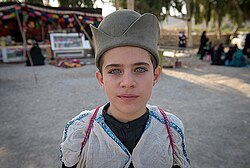
Back Caixcais AN قشقاي Arabic قشجاى ARZ Qaşqaylar Azerbaijani قاشقای تورکلری AZB Ҡашҡайҙар Bashkir Кашкайцы Byelorussian Qaixqais Catalan Кашкай CE قەشقایی CKB
  Qashqai traditional market (top) Qashqai boy wearing a traditional hat (bottom) | |
| Total population | |
|---|---|
| c. 300,000-2,000,000[1][2][3] | |
| Regions with significant populations | |
| Southern Iran, Central Iran | |
| Languages | |
| Qashqai, Persian | |
| Religion | |
| Shia Islam[4] | |
| Related ethnic groups | |
| Lurs, Kurds, Arabs,[5] Other Turkic peoples Especially Chaharmahali Turks |
Qashqai people[a] (pronounced [ɢæʃɢɒːˈjiː]; Persian: قشقایی) are a Turkic tribal confederation in Iran. Almost all of them speak a Western Turkic (Oghuz) language known as the Qashqai language – which they call "Turkī" – as well as Persian (the national language of Iran) in formal use. The Qashqai mainly live in the provinces of Fars, Khuzestan, Kohgiluyeh and Boyer-Ahmad, Chaharmahal and Bakhtiari, Bushehr and southern Isfahan, especially around the cities of Shiraz and Firuzabad in Fars.
The majority of Qashqai people were originally nomadic pastoralists and some remain so today. The traditional nomadic Qashqai traveled with their flocks twice yearly between the summer highland pastures north of Shiraz roughly 480 km or 300 miles south and the winter pastures on lower (and warmer) lands near the Persian Gulf, to the southwest of Shiraz. The majority, however, have now become partially or wholly sedentary. The trend towards settlement has been increasing markedly since the 1960s under government pressure, and encouragement, which has built housing for those willing to settle, starting in the early 20th century during the reign of the Pahlavi dynasty. However, for those who continue their migratory lifestyle, the Iranian government maintains and controls travel corridors for the Qashqai and their livestock, and other populations practicing pastoral migrations.[6]
The Qashqai are made up of five major tribes: the Amale (Qashqai) / Amaleh (Persian), the Dere-Shorlu / Darreh-Shuri, the Kashkollu / Kashkuli, the Shishbeyli / Sheshboluki and the Eymur / Farsimadan.[7] Smaller tribes include the Qaracha / Qarache'i, Rahimli / Rahimi and Safi-Khanli / Safi-Khani.
- ^ Arakelova, Victoria (2015). "On the Number of Iranian Turkophones". Iran and the Caucasus. 19 (3): 279. doi:10.1163/1573384X-20150306.
The main body of the Iranian Turkophone mass generally consists of two parts: proper Turkic groups—the Turkmen (from 0,5 to 1 million), partially the Qashqays (around 300,000), as well as Khalajes (currently Persian-speakers living in Save, near Tehran); and the Turkic-speaking population of the Iranian origin, predominantly the Azaris, inhabiting the north-west provinces of Iran roughly covering historical Aturpātakān.
- ^ Transformations of Middle Eastern Natural Environments: Legacies and Lessons. Yale University. 1998. p. 59.
the Qashqa'i are members of a tribal confederacy of some 800,000 individuals
- ^ Potter, Lawrence G. (2014). Sectarian Politics in the Persian Gulf. Oxford University Press. p. 290. ISBN 978-0-19-937726-8. Retrieved 14 January 2023.
- ^ Adamec, Ludwig W. (2017). Historical Dictionary of Islam (3 ed.). Rowman & Littlefield. p. 515. ISBN 978-1442277243.
- ^ Foundation, Encyclopaedia Iranica. "QAŠQĀʾI TRIBAL CONFEDERACY i. HISTORY". "Like most present-day tribal confederacies in Persia, the Il-e Qašqāʾi is a conglomeration of clans of different ethnic origins, Lori, Kurdish, Arab and Turkic. But most of the Qašqāʾi are of Turkic origin, and almost all of them speak a Western Ghuz Turkic dialect which they call Turki." In: Encyclopaedia Iranica. Retrieved 13 May 2015.
- ^ "Country Studies:Iran".
- ^ Dolatkhah, Sohrab (2016). Le qashqay: langue turcique d'Iran. Online: CreateSpace, Independent Publishing Platform. p. 13.
Cite error: There are <ref group=lower-alpha> tags or {{efn}} templates on this page, but the references will not show without a {{reflist|group=lower-alpha}} template or {{notelist}} template (see the help page).